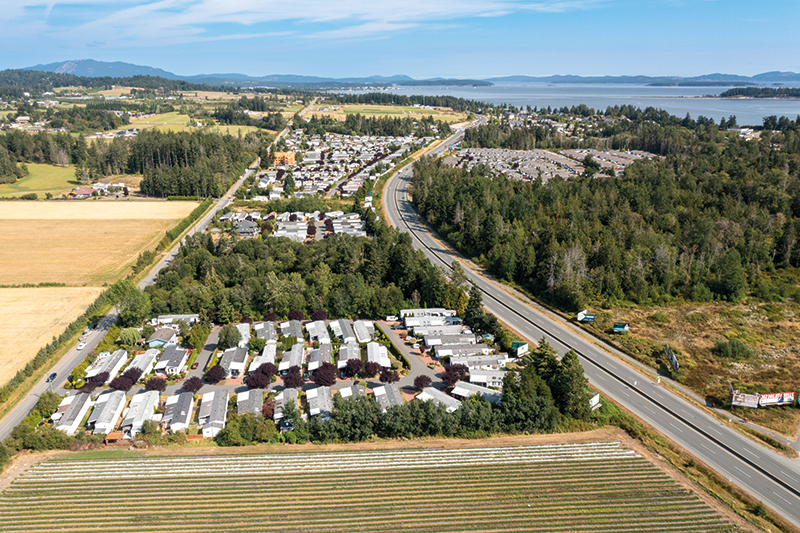Long-term financial planning for municipal governments
By Arshad Akhtar
Nothing happens until it’s funded. Long-term financial planning is increasingly becoming one of the most important components underpinning a successful asset management program. Municipalities must address competing priorities, making responsible and efficient long-term financial planning more important.
When communities establish a long-term financial vision, it empowers them to progress with confidence, providing a strategic roadmap for managing resources over an extended period, while ensuring sustainability and enhancing transparency. This article explores the benefits of long-term financial planning for infrastructure asset management and provides examples of best practices from across Canada. It examines lifecycle costing practices, long-term funding strategies and accounting for natural assets and climate change. It also shares ways communities can leverage financial planning to:
- Optimize the service delivery and performance of their assets.
- Make informed and cost-effective decisions for the long term.
- Address the maintenance and capital renewal backlog.
- Promote intergenerational funding equity and capital service equity.
- Protect and enhance natural assets and prepare for the impacts of climate change.
The case studies in this article are exactly the type of work the Federation of Canadian Municipalities (FCM) has been supporting through its Municipal Asset Management Program, funded by the Government of Canada. Numerous local governments have reported that municipal grants or training activities have given them the ability to demonstrate the gap between forecasted infrastructure needs and current spending levels. With funding from the Municipal Asset Management Program, over 300 Canadian local governments have worked on projects or received training that helped them progress in budgeting and financial planning with respect to asset management.
Municipalities are responsible for providing essential services to their communities, such as water, wastewater, and transportation. These services are considered “non-discretionary” and often account for more than 90 per cent of a municipality’s core infrastructure services. It is uncommon for municipalities to reduce capital services, which makes long-term financial planning a critical component of their operations. Communities, therefore, need to understand the full lifecycle cost before building new infrastructure.
In March 2022, the Prince George Community Foundation and Rotary approached the City of Prince George, B.C., with a proposal to build a mega-destination park. The park would include a pump track, junior and teen adventure parks, a senior-friendly outdoor fitness station and a splash pad and would be inclusive and accessible while promoting economic development. The Foundation indicated that they had secured funding for much of the design and construction, while the city would contribute the land and other park amenities such as landscaping, site servicing and parking, as well as cover operating and maintenance costs such as mowing and equipment repair for the life of the park. The question the City faced was the proposal’s long-term financial implications. How could they ensure it was in the community’s best interests both functionally and financially?
Financial planning and equity
Long-term financial planning and lifecycle costing are proving to be useful tools to minimize future costs and catalyze infrastructure renewal and intergenerational funding equity. Establishing sustainable funding has spurred capital renewal, ensuring all generations have equitable access to functioning infrastructure.
The District of Saanich, B.C., shows how long-term financial planning can help improve intergenerational funding equity and secure long-term funding. In 2007, they estimated that actual annual infrastructure funding was only 30.5 per cent of the amount required to fund long-term infrastructure renewal, meaning that future generations would have to pay significantly more to enjoy similar infrastructure. From 2007 through 2019, Saanich gradually built up to 47.7 per cent of sustainable funding levels and continues to work on reducing the gap.
Similarly, the District of Oak Bay, B.C., has taken steps to close its annual funding gap, but in half the time. In 2018, the district began substantially increasing annual infrastructure funding from $3.7 million, or 31 per cent of replacement costs. By 2023, it had reached $10 million, or an estimated 75 per cent of annual infrastructure replacement costs. This strategy has spurred capital spending, and the district is forecasting a new capital spending record for the fifth year in a row. It has optimized spending, too. Staff are now empowered to invest in proactive maintenance and reduce lifecycle costs. This contrasts with the approach of deferring capital maintenance to keep short-term tax rates low.
Long-term financial planning has had a massive impact on intergenerational funding equity in these communities. The objective of funding equity is to ensure that all generations of capital service users pay a similar amount for a similar service. In Oak Bay, the aggressive effort to close the funding gap has added more than $630 million to infrastructure replacement funding over the next 100 years.

One relevant factor is the growing desire among financial professionals for infrastructure replacement costs to be formally disclosed in financial statements. This would enable the public to better understand and judge funding equity. Currently, financial statements report the value of assets at historical cost (the cost when acquired or constructed). However, for long-lived assets in high-inflation environments, this value does not provide a relevant prediction of future replacement costs.
The City of Rossland, B.C., for instance, is considering voluntary disclosure in its financial statements. Justin Brogan, a Chartered Professional Accountant with the City, was quoted in the December 2023 edition of the Government Finance Officers Association of British Columbia newsletter as saying, “I believe this issue is one where it is crucial to get the narrative right and ensure users are provided with better information to understand pending asset replacement costs. When it comes to how this might look in a voluntary disclosure, we’d like to borrow from the approach many jurisdictions are using with respect to natural assets disclosures, which have been focused on providing users with basic, unaudited information to acknowledge a fundamental risk and opportunity communities face.” This intention is supported by the City’s Tangible Capital Asset Policy, which calls for the disclosure of replacement values in the City’s financial statements.
Financial planning and natural assets
Local governments across Canada have been making efforts to recognize the value of their natural assets in addition to their built assets. Too often, municipalities fail to quantify and consider cost savings due to the presence of natural assets. For instance, a municipality may benefit from the drainage or recreational services that a river provides. A community could choose to value a natural asset by determining how much it would cost to provide a similar service using built infrastructure.
In 2017, for example, a pilot study was initiated by Credit Valley Conservation for the Region of Peel to test a model to assess stormwater services provided by natural assets within Peel’s jurisdiction. The study tested the water retention and flow attenuation provided by the southern Ontario region’s wetlands, forests, green spaces, and watersheds.
The study concluded that building infrastructure to provide a similar stormwater service would cost $704 million under current conditions and a significantly higher $764 million under climate change conditions. Thus, valuing and maintaining natural assets can help a municipality avoid additional infrastructure costs. Holistic long-term financial planning empowers councils to consider all costs borne by municipalities for their natural and built infrastructure for the entire lifecycle.
Consideration of natural assets is increasingly becoming a mandatory part of a community’s asset management policy, such as in the County of Grande Prairie, Alta. Their policy states that “natural assets and green infrastructure must be accounted for and valued when making decisions regarding infrastructure projects… The County recognizes the value of natural assets in supporting service delivery and reducing the need for engineered assets and will strive to make advances in integrating natural assets into asset management practices.”
These case studies demonstrate that financial planning may be the most effective way for communities across Canada to make progress in asset management.
As for Prince George, they wisely conducted a lifecycle costing analysis on the destination park proposal.
Through consultation, the city found strong community support for the project, though the report Council received on July 25, 2022, noted not all upfront costs were known, and further cost analysis would be needed to understand the project’s full lifecycle cost, including operations, maintenance, and eventual replacement. The report recommended that staff return with a full lifecycle analysis of the project’s financial implications, which the Council accepted.
In December 2022, staff presented a full lifecycle analysis. Initial capital costs, estimated at $2.84 million by the Community Foundation, were potentially covered by donations. However, additional costs not originally considered amounted to $10.5 million and $12.1 million for operating and maintenance over the asset’s life span, plus an extra $41.6 million in capital renewal costs. In total, the community might be responsible for more than $68.3 million. Put another way, the estimated annual lifecycle cost that would need to be added to the municipality’s budget was $1.4 million.
Ultimately this information led to a delay pending the definition of 2023 budget priorities. In the end, the park project was a no-go. Asset management staff are committed to ensuring that the Council has all the facts it needs. They are not anxious to kill projects, but rather to ensure that municipalities have the benefit of full information so they can make the decisions that are best for their communities, now and in the future.
The creation and adoption of a community’s long-term financial vision actively shapes its future resilience and adaptability. Through embracing some of the lessons identified from successful local governments, your community can be poised to thrive while navigating evolving challenges.
Arshad Akhtar is sector lead for the Federation of Canadian Municipalities’ (FCM) Municipal Asset Management Program.
[This article originally appeared in the March/April 2024 edition of ReNew Canada]
Featured image: After fully investigating the long-term financial implications of a proposed park, the City of Prince George, B.C., has put the plan on hold while they further investigate the project’s annual lifecycle costs. (Getty Images)
















